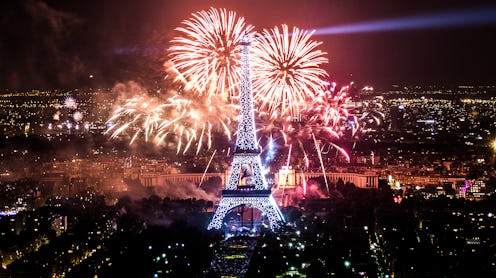Life
5 Things You Need To Know About Bastille Day

I love any excuse to indulge in delicious cheese and pastries, sip a big glass of wine, and just celebrate in general — and Bastille Day fits that bill perfectly. However, I'm also that know-it-all who likes to seem worldly and cultured by whipping out historical facts about the holiday over a glass of champagne. What is Bastille Day, exactly? Yup, I was curious too. That's why this year I decided to brush up on important Bastille Day details before reaching for the cheese plate. It's always smart to be prepared, right?
Sure, celebrating is one thing. But, sometimes it's also nice to know a bit of the history behind why you're actually celebrating. Not only do you get to seem intelligent and like you'd be the world's best trivia partner in front of your friends, but knowing the historical backstory also puts the celebration into context and adds a little more meaning to the holiday.
In honor of Bastille Day, I've rounded up some need-to-know facts about the French National Holiday. Whether you just want to be more informed about the historical meaning of the day, or you want to have an arsenal of information that you can spout out at your French-themed celebration, here's the down and dirty on what you should know about La Fête Nationale.
1. What exactly is Bastille?
Bastille is the name of a medieval fortress prison that was located in Paris. Under the rule of Louis XVI's government, people were held captive for completely arbitrary reasons. Even worse, the prisoners were detained on royal indictments that simply couldn't be appealed. Basically, they were stuck.
2. What historical moment is Bastille Day honoring?
This completely unfair imprisonment became a symbol of oppression for the people of Paris, and they eventually reached their limit. On July 14, 1789, they stormed the fortress, which marked the start of the French Revolution. There were only seven prisoners inside Bastille that day, but this rebellion symbolized liberation of the French public and the start of French independence.
3. What colors are on the French flag, and what do they mean?
The colors should be pretty easy for you to remember — they're red, white, and blue. When the tricolor flag was officially adopted in 1794, these colors were said to represent the revolutionary values of Liberté, Égalité, and Fraternité, which translates to liberty, equality, and brotherhood.
4. What Bastille Day celebrations occur in France?
Similarly to Independence Day here in America, Bastille Day is a pretty big deal in France. Perhaps the most traditional celebration is the Bastille Day Military Parade, the oldest and largest military parade in Europe. France's fire stations also open their doors for Fireman's Ball, a series of celebrations that essentially turn the entire city into a big, outdoor fair. There's also a gorgeous fireworks display set off from the Eiffel Tower, and — of course — tons of delicious French cuisine.
5. Why do we celebrate Bastille Day in America?
As you might have gathered from the backstory of Bastille Day, France and America share quite a few historical commonalities. The concept of overcoming monarchial oppression definitely resonates with the United States. Additionally, France and America share a lot of the same views on human rights. Our Bill of Rights and Declaration of Independence bear a striking resemblance to France's Declaration of the Right of Man and of the Citizen. Honestly, we even share the same flag colors.
Celebrating Bastille Day in America is a great way for us to honor our common histories, as well as the fact that we've been helping each other out for the past couple hundred years. In fact, many larger U.S. cities host Bastille Day celebrations, including Brooklyn, Philadelphia, and Milwaukee. New Orleans, which is coined "America's Most French City," hosts a huge Bastille Day event, which includes film festivals, live music, and tons of food.
Images: Yann Caradec, Manu Dreuil, side78, Quinn Dombrowski, Yann Caradec/Flickr; Getty